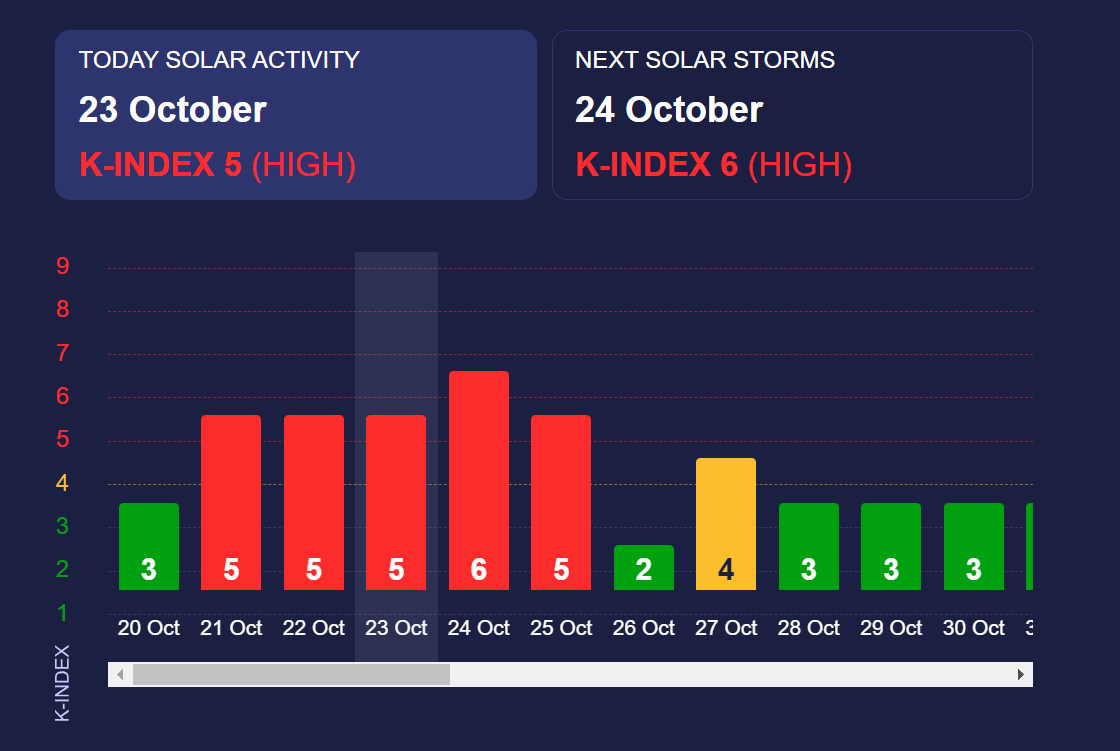High-level magnetic storm approaching: Details and impact
 A powerful magnetic storm is approaching Earth (Collage by RBC-Ukraine)
A powerful magnetic storm is approaching Earth (Collage by RBC-Ukraine)
A powerful magnetic storm with a K-index of 6, corresponding to a red level, is approaching Earth. Moreover, this geomagnetic storm will last for several days, and the weakening will only come on October 26.
What is known about this magnetic storm and how to protect your body, is reported by RBC-Ukraine, based on Meteoagent data.
What is a magnetic storm?
Solar energy emissions caused by various eruptions and flares on the Sun lead to an increased geomagnetic situation. Solar energy during such eruptions scatters in various directions, including towards Earth.
This energy consists of charged particles (protons and electrons) that can move very quickly through space. When these particles collide with Earth's magnetosphere, they trigger activity known as solar or magnetic storms.
Storms are distinguished by their strength, which depends on the flares. Minor magnetic fluctuations are mostly imperceptible and are classified with K-index 2 to K-index 3. Storms with a K-index of 4 are more noticeable.
All storms classified with an index higher than K-index 5 are red-level storms. They can cause disruptions in satellite operation, GPRS, mobile communication, and electric grid operation. More powerful storms can lead to phenomena such as the auroras.
Furthermore, strong magnetic storms can affect the well-being of many people on Earth.
Magnetic storm in October
According to data from NOAA satellite systems, TESIS, and international meteorological laboratories worldwide, a magnetic storm with a K-index of 5 enveloped the Earth on October 21.
Tomorrow, October 24, this storm will become even stronger, reaching a K-index of 6, which corresponds to a red-level magnetic storm.
This storm is prolonged, and the geomagnetic activity will only subside on Thursday, October 26.
 Magnetic storm, October 21-25 (screenshot)
Magnetic storm, October 21-25 (screenshot)
Impact of magnetic storms on people Scientists from around the world have been studying the effects of magnetic storms on people for many years, and there is still no consensus. However, numerous studies confirm a link between people's deteriorating well-being and magnetic storms.
During such days, people more frequently complain of weakness, headaches, and often seek medical attention, including from cardiologists.
Common complaints include:
- Headaches, migraines, and dizziness.
- Insomnia or excessive sleepiness.
- General weakness and worsened well-being.
- Increased fatigue, decreased concentration, and productivity.
- Heightened anxiety, depression, irritability, and aggression.
The greatest danger from such storms is posed to astronauts who are beyond the protective shield of Earth's atmosphere. They can be exposed to high levels of radiation, significantly increasing the risk of cancer development.
What to do during magnetic storms
Medical professionals provide patients with general recommendations during these days, advising them to rest more, get proper sleep, avoid overexertion, and breathe fresh air.
Additionally:
- Sleep for 7-9 hours and maintain a regular daily schedule.
- Balance work and leisure.
- Eat a balanced diet and drink an adequate amount of water.
- Spend time outdoors daily.
- Reduce stress and avoid excessive strain.
- Seek medical advice from a family doctor if necessary.

